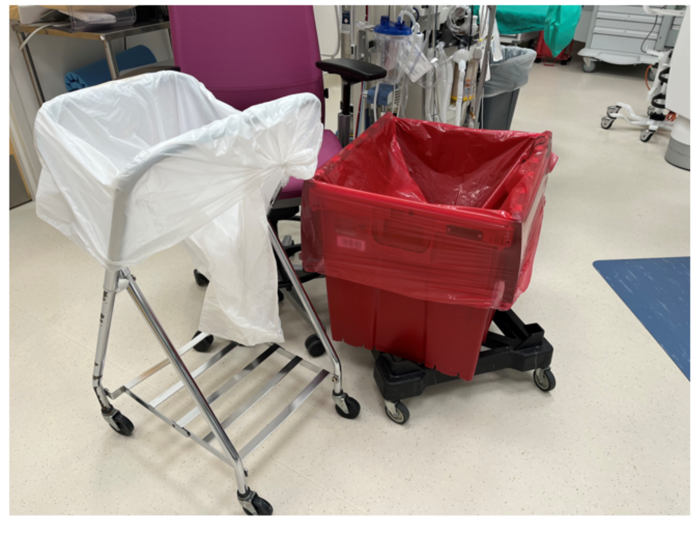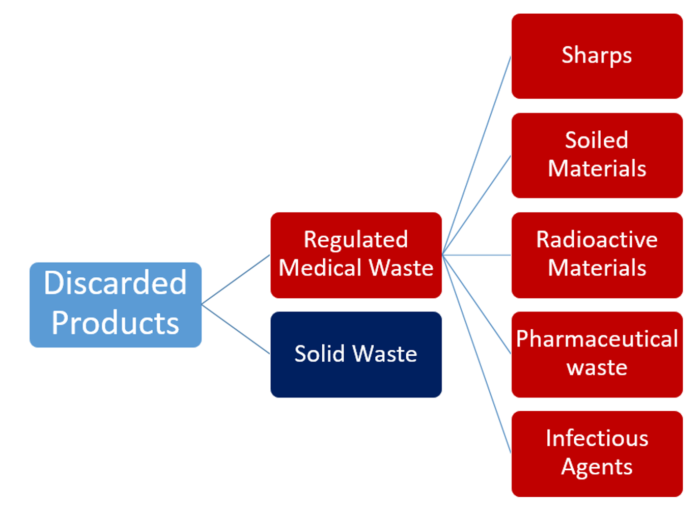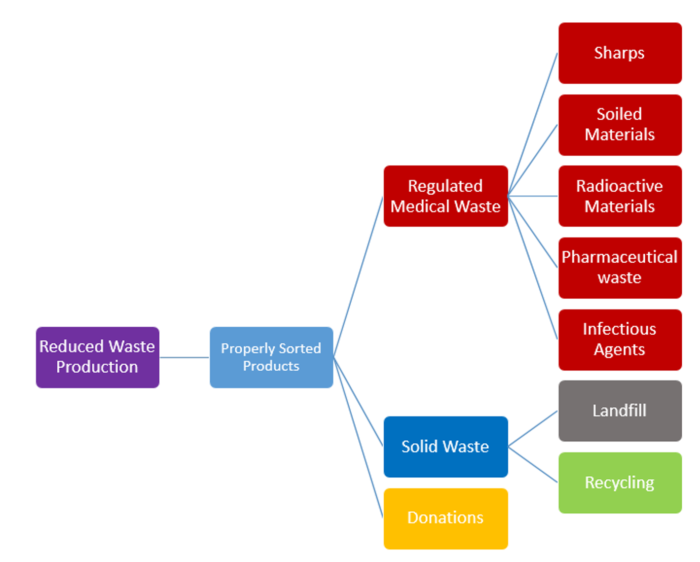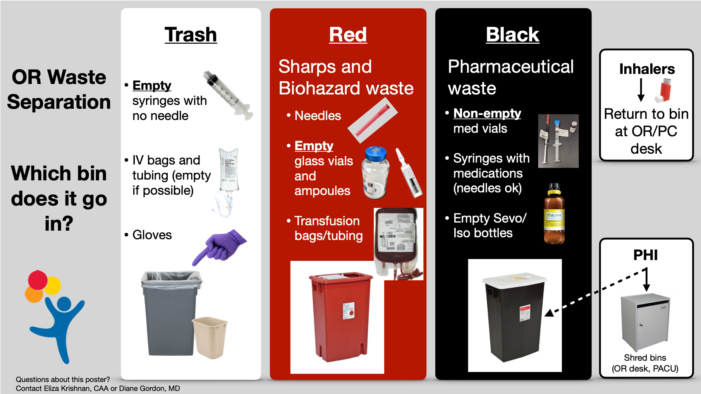Copy link
Anesthesia-Related Waste Streams
Last updated: 09/12/2023
Key Points
- Anesthesia-related waste can be categorized as regulated medical waste, which requires special processing, and solid waste, which doesn’t require special processing.
- Much of the waste produced by anesthesia care is inappropriately placed in regulated medical waste streams, resulting in increased environmental impact as well as cost.
- Anesthesia providers have an opportunity to reduce their environmental impact by initiating programs to reduce waste reduction and improve waste sorting, promote the utilization of reusable products, and donate used products where they are needed.
Introduction
The Scale of Anesthesia-Related Waste
- American healthcare facilities produce large volumes of medical waste per year and contribute about 8% of US greenhouse gas emisions.1
- Surgical departments are major contributors to healthcare-generated waste, accounting for 20-30% of total hospital garbage production.2
- Anesthesia services may account for around 25% of all waste produced in operating rooms.3
- One study estimated that anesthesia services generated 2,300kg of waste per operating room (OR) per year.4
Types of Waste
- Waste produced in the healthcare setting is broadly divided into solid waste (SW) and regulated medical waste (RMW).

Figure 1. Typical SW (white) and RMW (red) receptacles
- SW includes noncontaminated products, which may be removed using standard waste removal protocols (or recycled, if eligible). The World Health Organization estimates that 80% of healthcare-generated waste should be categorized as SW.5
- RMW requires special processing to keep the public safe from contaminants, such as infectious agents.5 Subcategories of RMW may include:
- materials soiled with bodily fluids or other potentially infectious materials; and
- sharp objects, including needles, scalpels, or contaminated glass containers, which could cause bodily injury or act as a source of infection.
- Radioactive materials used in treatments of certain diseases, such as cancer.

Figure 2. Typical OR waste stream
Effects and Challenges in Anesthesia Waste Management
Environmental & Economic Impacts of Waste Types
- Solid waste generated by healthcare facilities poses no more risk than SW produced in any other setting.
- Regulated medical waste requires additional processing, through either steam sterilization before landfill placement or through incineration. Steam sterilization is an energy-intense process, and incineration produces greenhouse gas emissions and may release multiple environmental toxins.6
- As a result of the special handling and processing required, RMW is up to 500% more expensive to eliminate than SW.2
Possibilities for Improvement
Reuse, Recycling, and Donation
- One way to reduce anesthesia waste production is by utilizing multi-use products, such as nondisposable laryngoscope handles and blades. Such instruments are both more environmentally friendly and cheaper over time.7
- A large portion of waste generated by anesthesia practice is recyclable.3 Recycling items removes them from either the SW or RMW streams.
- Anesthesia equipment which is no longer useful in high-resource settings may be invaluable in low-resource settings. Items to be donated may be as complex as older-model anesthesia machines or as simple as disposable items which are no longer needed. However, care must be taken to avoid donating broken, unusable, or unmaintainable items.2

Figure 3. Improved waste management system
Opportunities for Quality Improvement and Education
- Though a large proportion of anesthesiologists support green initiatives, many report a lack of institutional support as a barrier to involvement.8
- Improving the amount and distribution of anesthesia-related waste requires action at the personal, departmental, and institutional levels. It also offers opportunities for anesthesia providers to become leaders and environmental champions within their workplace.
- Despite the challenges faced, many successful environmental quality improvement initiatives have been initiated by anesthesiology departments. These have included:
- initiatives to reduce wastage of disposable products, like endotracheal tubes;9
- an initiative to dispose of CO2 absorbers into the SW stream instead of the RMW stream; and10
- an initiative to promote better waste segregation by anesthesia providers, resulting in a dramatic reduction in RMW related to anesthesia care.1

Figure 4. An example of a waste separation poster; note that each institution has specific policies that govern the correct placement of many waste items.
- All anesthesia-driven environmental initiatives require proper education of the anesthesia team, including anesthesia technologists, advanced practice providers, and anesthesiologists.
References
- Fraifeld A, Rice AN, Stamper MJ, et al. Intraoperative waste segregation initiative among anesthesia personnel to contain disposal costs. Waste Manag. 2021; 122:124-31. PubMed
- Axelrod D, Bell C, Feldman J, et al. Greening the operating room and perioperative arena: Environmental sustainability for anesthesia practice; 2015. ASA Task Force on Environmental Sustainability. Accessed April 17, 2023. Link
- McGain E, Hendel SA, Story DA. An audit of potentially recyclable waste from anesthetic practice. Anaesth Intensive Care. 2009; 37:820-823. PubMed
- Hutchins DCJ, White SM. Coming round to recycling. BMJ. 2009;338: b609. PubMed
- Chartier Y, Emmanuel J, Pieper U, et al. Safe management of wastes from health-care activities. 2nd ed. Geneva: World Health Organization; 2014.
- Hubbard RM, Hyanaga JA, Quinlan JJ, et al. Optimizing anesthesia-related waste disposal in the operating room: A brief report. Anesth Analg 2017; 125:1289-91. PubMed
- McGain F, Muret J, Lawson C, Sherman JD. Environmental sustainability in anaesthesia and critical care. Br J Anaesth. 2020; 125(5):680-92. PubMed
- Ard JL, Tobin K, Huncke T, et al. A survey of the American Society of Anesthesiologists regarding environmental attitudes, knowledge, and organization. AA Case Reports. 2016;6(7):208-16. PubMed
- Denny NA, Guyer JM, Shroeder DR, et al. Operating room waste reduction. AANA J. 2019;87(6):477-82. PubMed
- Burbridge MA, Chua P, Jaffe RA, et al. An anesthesia attempt to be green: How do you waste your carbon dioxide absorbers? AA Pract. 2019; 13(11):440-1. PubMed
Copyright Information

This work is licensed under a Creative Commons Attribution-NonCommercial-NoDerivatives 4.0 International License.